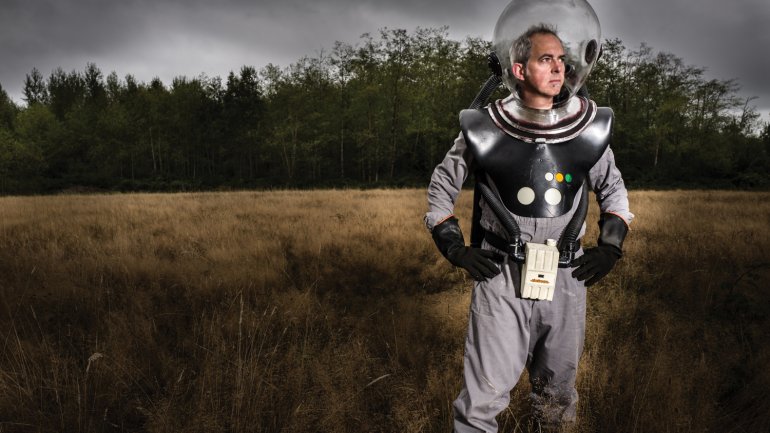Rocket Man
Rocket Man
Space. It’s the final frontier, as any Trekkie can tell you – whether that means the outer reaches beyond the stars or the inner realms of your own mind. Rik Allen’s blown-glass and metal art evokes exploration of both kinds. Rocket ships, cosmonauts, and space helmets sport the cheery, chunky gleam of midcentury sci-fi imagery, but with the slightly battered patina of experience. Where might these ships already have traveled? Where could they go next? Inside some of the ships are tiny telescopes and lone red chairs. For whom – past pilots or ones yet to come?
Allen’s fascination with imaginative journeys is evident even in his earliest artwork. Growing up in Providence, Rhode Island, he was a “distracted kid who drew on everything.” He populated his junior high and high school notebooks with doodled scenes from Star Wars and fantastic creatures, and admired the cool-looking aircraft diagrams his father, an inspector for the Air Force, brought home from work.
But Allen, 49, saw his future in science, not art. It wasn’t until he was studying anthropology in college, and taking a few ceramics and drawing classes on the side, that his course shifted. After graduation, he returned to Providence and worked as a studio assistant for several ceramic, glass, and mixed-media artists. “I really lucked out and got to work with pretty fantastic people,” he says.
In 1994, one of his artist employers, James Watkins, invited Allen to be his teaching assistant at Pilchuck Glass School in Washington state. Allen was smitten with the school, its community of artists, and the laid-back Pacific Northwest. (He met his wife, glass artist Shelley Muzylowski, on that first trip; they married in 1998). He became a permanent West Coaster the following year, joined innovative glass master William Morris’ studio, and stayed until Morris retired in 2007. “He was a courageous artist who wasn’t afraid to do anything,” Allen says. “As a team, we would problem-solve anything that interested Bill. I learned a ton.”
Allen deftly applies that experimental approach to his own projects. He begins work on each of his futuristic artifacts with elaborate sketches that evolve with the project – the sophisticated successors of those early notebook doodles. For a typical spaceship, once the main form is blown in glass, he might let it cool and engrave details onto it. He might cut out windows, reheat the form, and blow a second one inside it, letting the new windows bulge outward, often covering the outer form in foil while it’s hot to create a fusedon metallic skin. Then it’s on to the metal shop, part of the 5-acre home and studio complex in northwestern Washington he shares with his wife; then Allen and 20-year collaborator Jeremy Bosworth – “friend, colleague, and right-hand man” – brainstorm how to make and fit ladders and legs and the tiny telescopes and chairs.
“The little chair has now become more and more of a focus,” Allen says. “For me, it’s a placeholder for your mind. You can put yourself there and imagine yourself being in some other space, where you’re exploring, looking out. I think they have a beautiful poetry that’s very, very simple.”
The chair itself is modeled after the stackable red chairs Allen remembers from his school days, “that time when we’re absolutely the most curious and the most blown away” by every new discovery.
He’s retained that sense of curiosity – which, on at least one occasion, brought him into contact with a world far, far away from his own: As a visiting artist at the Chrysler Museum of Art in Norfolk, Virginia, this past spring, he was offered the chance to visit NASA. There, he hung out with scientists, including some who are developing vehicles for missions to Mars and its moons. One of their ship designs especially caught Allen’s fancy. He decided to re-create it and invited the NASA scientists to come to the museum and watch him work.
“I realized how similar artists and scientists are in a lot of ways. They’re all creative people,” Allen says.
“The conversations that happen are very easy. You feel you’re on the same wavelength.” Allen is optimistic that scientific exploration – terrestrial and beyond – can help humans learn to live in better balance with the planet.
“Ultimately we are alone in our own minds, looking out in the world from behind our eyes,” he says. “We’re a fleet of little ships, all together, flying to our destination.”
Barbara Haugen is American Craft’s shows editor.

